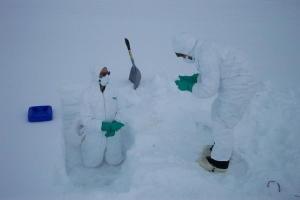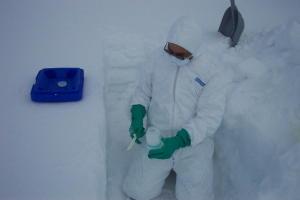24 March, 2002
Imagine putting on layers of clothes, mittens, hats, thick bunny boots, and
zooming around on a snowmachine in the remote Alasaka wilderness to take
cold, snow measurements. Remember that cold 10 to 12 hours of working in
the Arctic cold to take the measurements. Now picture the “blue men” on
the Pentium Processor commercials doing their crazy art with their white
suits dazzling. Let’s now combine the two pictures the “blue men” doing
Science in the cold Arctic. That is precisely what is required to do
chemical sampling of the snow.
Chemical sampling requires putting on layers of latex gloves, a white paper
suit called a Tyvek suit and a mask for your face. Life/Science just got a
little tougher in the Arctic. However, these chemical samples are very
important and fascinating. They are breaking new science in the Arctic.
These samples of snow will be sampled for chemicals. They are called Class
I chemical samples. These samples of snow will be tested for mercury and
other trace elements such as cadium, zinc, and vanadium. To test for
traces of these elements the samples must be taken in clean mode. The
“clean” mode means that the samples of snow cannot be contaminated. That
means the people collecting the snow have to be very careful to not add any
small amounts of the elements into the snow sample. The latex gloves are
worn so nothing from the hands can enter the snow samples. The Tyvek suit
is worn so nothing from the clothes/body can be transferred to the samples.
The mouth/nose protector is worn so no SNOT or spit can get into the snow.
That’s pretty important Who would want to measure snot in the snow?”
All of this care must be taken with the samples because the trace elements
that we are measuring may only exist in minute parts of parts per million
or parts per trillion. So, why all of the trouble in the cold for these
measurements??????
The chemical sampling will be able to detect if there is any pollution in
the Arctic. The atmospheric air currents carry the air and any pollution
with it. The air currents that are responsible for the Arctic’s weather
patterns brings air from Northern Asia, Northern Europe and parts of
Russia. So we will be able to determine if the industrial, city activities
here on Earth are being transported to the remote parts on Earth. The zinc
would be a by-product produced in catalytic converters in automobiles. The
vanadium is found in fuel in automobiles. The cadium and mercury will
bioaccumulate in animals. This means that if a fish ingests these elements
into their system and then a bird eats the fish, and something eats the
bird and so on… Each time the energy is transferred the amount of elements
is transferred. The concentrations are increasing greatly during each
transfer. So, if the elements make it to humans, it can be in high amounts
and very damaging!
So, what does all of this mean?? So what if there are high amounts of these
elements in the snow in the Arctic. Well, if pollution exists here in the
Arctic, then we need to understand the consequences of such an act and
start planning accordingly. This could have Earth altering effects that
are extremely important to humans and life on our planet.
WHERE IS MRS. CHEUVRONT LET'S PLOT....
Still in Council....moving soon.
Temperature: 30 F light snow/cloudy

Glen and me collecting the snow for chemical sampling. Details! Details!

Glen working in the snow pit to collect chemical samples. Notice the 500 ml bottle used. Math question later on this topic.
Contact the TEA in the field at
.
If you cannot connect through your browser, copy the
TEA's e-mail address in the "To:" line of
your favorite e-mail package.
|
